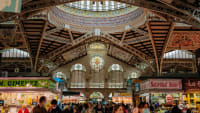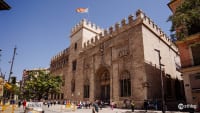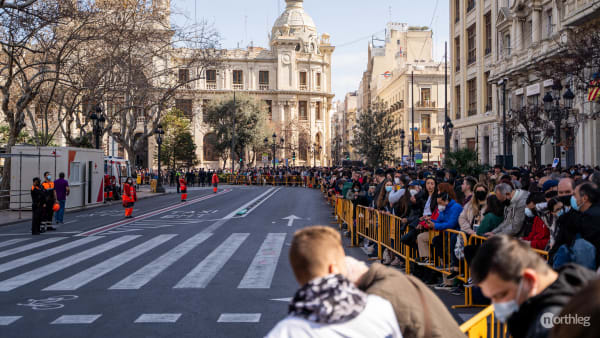Nearby places of interest
Nearby places of interest
Being opposite the Old Town, Valencia’s main train station is rather close to many of the city’s landmarks and important buildings.
Plaza de Toros, also known as the Plaça de Bous is Valencia’s bullring, one of the most beautiful and largest in Spain. It is still active to this day, meaning you can see corridas and bullfighting events in it. It bears a strong resemblance to civil Roman architecture, particularly the Colosseum.
The Plaza de Toros is just next to Estación del Norte, so you’ll only need to cross Carrer d’Alacant (to your right, keeping the station behind you) to reach it. This will only take you about a minute.
If you want to know more about Valencia’s bullring, you can read our article about the Plaza de Toros.
Plaza del Ayuntamiento or Plaça de l’Ajuntament in Valencian, is the City Hall square in Valencia. As such, it is one of the most important and central squares of the city. Every day, locals can be found relaxing by its fountain and enjoying the view of its flower market.
Estación del Norte is only 300 m away south of the Town Hall Square (4-minute walk, less than 0.2 miles).
If you want to know more about the City Hall square, you can check out our article about Plaza del Ayuntamiento.
Ruzafa (or Russafa, in Valencian) is a popular neighbourhood in the Eixample of Valencia. It is more modern than the old quarters of the city, and it features many chic venues, beloved by locals and tourists alike.
Ruzafa is known for its indie art galleries and stores, American-style bakeries, cafes with terraces, as well as trendy bars and clubs. You can read more about this neighbourhood in our article about Ruzafa.
Going from the Estación del Norte to Ruzafa should take you around 5 minutes (400 m, just over 0.2 miles). From the side of the station, you can take Carrer d’Alacant and then Calle de Castelló on the left*.* In just a few minutes you’ll find yourself in Ruzafa.
The Mercat de Colón is one of the most beautiful buildings in Valencia and one of the most important examples of Valencian Art Nouveau .
In the past, the site had been a market like many of the others that can be found in the city, but today it is more of a dining and drinking venue, with fine restaurants, bars and outdoor cafés. Now renovated, this gated centre is decorated with ceramic details and sheltered by brick columns and a wrought-iron roof.
The Mercat is only 900 m east (11-minute walk, a little under 0.6 miles) of the Estación del Norte.
If you would like to know more about this building, you can check out our article about the Mercat de Colón.
Valencia’s Central Market is Europe’s biggest fresh produce market and one of the city’s most important modernist buildings.
A building that embodies and encapsulates Valencia’s craftsmanship, agricultural heritage and artistic traditions.
The Central Market is just 750 m north (10-minute walk, almost 0.5 miles) of the Estación del Norte.
If you would like to know more about this building, you can check out our article about the Central Market.
The Lonja de la Seda (Silk Exchange, in English), completed in the first decades of the 1500s is one of the main examples of Valencian Gothic civil buildings.
The building illustrates the power and wealth held by Valencia in its Golden Age, when it became one of the great Mediterranean mercantile cities. This structure, its halls, and its patio can today be visited and explored.
The Lonja is just in front of the Central Market, so its entrance is only 850 m away (11-minute walk, a little under 0.6 miles) from the station.
If you want to know more about it, you can read our article about the Lonja de la Seda.




















